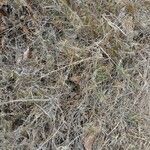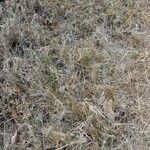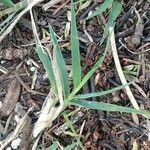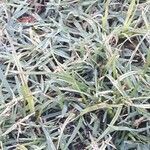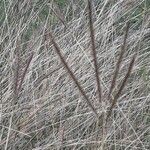Perennial, stoloniferous, also with slender scaly rhizomes, sward forming. Culms slender, 10–40 cm tall. Leaf sheaths bearded at mouth, otherwise glabrous or thinly pilose; leaf blades linear, short and narrow, 1–12 cm, 1–4 mm wide, usually glabrous, apex subacute; ligule a line of hairs. Racemes digitate, (2–)3–6, 2–6 cm, straight or gently curved, rather stiff, spreading; spikelets overlapping by 1/2–2/3 their length. Spikelets 2–2.7 mm; rachilla extension ca. 1 mm, sometimes with minute rudimentary floret at apex; glumes linear-lanceolate, often purplish, usually more than half as long as floret, 1.5–2 mm, 1-veined, keel scabrous, thickened; lemma as long as spikelet, silky villous along keel, hairs straight, otherwise glabrous or lateral veins thinly villous, apex subacute; palea glabrous, keels scaberulous. Anthers more than 1 mm. Caryopsis subterete, scarcely laterally compressed. Fl. and fr. nearly all the year. 2n = 18, 36.
Rhizomatous. Culms erect or decumbent, c. 1 mm wide, herbaceous; flowering culms 10–37 cm high. Leaves: basal sheaths glabrous to hispid; orifice bearded; ligule a ciliate membrane or a fringe of hairs, 0.2–0.3 mm long; blade flat, folded or involute, 1–10 cm long, 0.5–3 mm wide, acuminate or acute, bright or dull pale green. Inflorescences digitate; branches 2–7, 2–5.5 cm long, rather rigid. Spikelets disarticulating above or between the glumes; rachilla prolonged, terminating at a vestigial floret or naked. Glumes ±equal, 50–80% of basal lemma, 1.4–2.5 mm long, ±equal in width, narrowly lanceolate. Basal lemma 1.8–3 mm long; keel wingless; hairs extending the length of the midnerve and sometimes arising in the lower half of the submargins. Anthers 1–1.2 mm long, orange or yellow or purple.
Stoloniferous sward-forming perennial with slender underground rhizomes; surface stolons slender, prostrate; culms slender, 8–40 cm. high, 0.5–1 mm. in diameter.. Leaf-blades flat, or folded when dry, often short and narrow, 1–12 cm. long, 2–4 mm. wide, glaucous, scaberulous, with or without scattered hairs; ligule a membranous rim 0.2–0.3 mm. long, ciliate on the edge.. Racemes usually 4–6, 1.5–6(–8) cm. long, in a single whorl.. Spikelets 2–2.5 mm. long; glumes lanceolate in side view, 1-nerved, the upper 1/2–3/4 as long as the spikelet; lemma silky pubescent on the keel; palea glabrous.
A grass with stems which lie over and are creeping. It has slender scaly rhizomes or underground stems as well as stolons or runners. They branch and root at the nodes. It grows 5-15 cm high and can spread very widely. There are hairs in two rows on opposite sides of the stem. Erect short flowering branches are usually less than 20 cm high. The leaves are about 1.5 to 3 cm long. The flower spikes are 5 cm long, spreading and green or purple. They spread out like fingers on a hand. The small flower spikes are overlapping and about 1.5 mm long.
Sward-forming perennial, 50-350 mm high; rhizomatous and stoloniferous. Leaf blade 25-120 x 1-3 mm; ligule a fringed membrane or a fringe of hairs. Inflorescence digitate or subdigitate, of (3)4 or 5(6) secund racemes in a single whorl; rachis flattened. Spikelets 2.0-2.5 mm long, strongly laterally compressed; glumes lanceolate in side view, 1-nerved; upper glume 1/2-11/2 as long as spikelet. Floret 1, bisexual, rachilla produced; lemma keel wingless, silky-pubescent; palea glabrous; anther 0.8-1.2 mm long. Flowering time Sept.-May.
Widely spreading by stolons and rhizomes and forming mats, the culms erect or ascending, 1–3 dm; main lvs 2–4 mm wide; spikes 4–6, divergent, 3–5(–8) cm; glumes 1.5–2.2 mm, the first curved, the second nearly straight; lemma 2–2.5 mm, minutely pubescent to long-villous on the keel; 2n=36, 40. Native of the Old World, abundant (and often cult.) in lawns and in disturbed sites in s. U.S. (n. to Del.) and adventive n. to N. Engl., Mich., and Nebr. (Capriola d.)
Rhizomatous, stoloniferous, widely creeping perennial; culms wiry, compressed, 10-40 cm. high; sheaths usually overlapping, keeled, glabrous or sparsely pilose at the throat; ligule membranaceous, minutely erose, 0.2-0.3 mm. long; blades flat, 2-20 cm. long (usually 5-10 cm.), 2-4 mm. wide, scabrous, especially on the margins, sometimes sparsely pilose; spikes 4-7, slender, arcuate, 2-7 cm. long; spikelets 2-3 mm. long.
Sward-forming perennial 50-350 mm high; rhizomatous and stoloniferous. Leaf blade 10-120 x 2-4 mm; ligule a fringed membrane or a fringe of hairs. Inflorescence racemes (3-)4-5(-6), in a single whorl. Spikelet 2.0-2.5 mm long; rachilla produced; glumes lanceolate in side view, 1-nerved; upper glume 1/2-3/2 as long as spikelet; lemma keel wingless, silky pubescent; palea glabrous; anther 0.8-1.2 mm long.
Perennial; up to 0.35 m high; sward-forming; rhizomatous and stoloniferous. Leaf blades 10-120 x 2-4 mm. Flowers: inflorescence digitate; racemes (3)4 or 5(6); in a single whorl; spikelets 2.0-2.5 mm long; glumes lanceolate in side view; upper glume 1/2-3/4 spikelet length; rachilla produced; lemma keel wingless.
Sward-forming perennial, rhizomatous and stoloniferous, up to 350 mm tall. Leaf blades 10-120 mm long, 2-4 mm wide. Spikelets 2.0-2.5 mm long. Racemes (3)4 or 5(6), in a single whorl; lemma keel wingless; upper glume half to three-quarters the spikelet length; rhachilla produced.
Mat-forming perennial, up to 400 mm tall. Leaves linear; ligule a fringed membrane. Inflorescence digitate, with 2-4(-6) one-sided racemes. Spikelets 2-2.5 mm, 1-flowered, awnless; glumes to 3/4 the length of spikelet; lemma keel wingless, hairy.
A common grass in lawns and on paths, and often a pest in agricultural land. Very variable in vegetative, and to a lesser extent spikelet, characters throughout its range, although specimens from a limited area are usually fairly constant.
Stoloniferous sward-forming perennial with slender underground rhizomes; surface stolons slender; culms slender, up to 40 cm tall, erect or ascending; leaf laminas 2.5–12 cm × 1–2(3) mm, flat, or folded when dry, often short and narrow.
Mat-forming perennial to 40 cm. Leaves linear. Spikelets secund, mostly 4 or 5 in digitately branched spikes, 2-2.5 mm, lemma keel wingless, glumes to three-quarters the length of spikelet.
Spikelets 2–2.6 mm long; glumes lanceolate in profile, the superior 1/2–3/4 as long as the spikelet; lemma silky-pubescent on the keel, sometimes thinly so.
Stems creeping, rooting at the nodes and producing from them fascicles of barren shoots and flowering culms; 7–40 cm. high.
Racemes usually 2–4(6) in a single whorl, 2–5.5 cm long.
